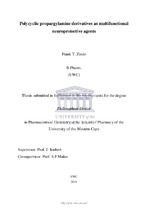| dc.description.abstract | The abnormal death of neurons in the central nervous system of individuals suffering from neurodegenerative diseases such as Parkinson’s disease, Alzheimer’s disease, Huntington’s disease and amyotrophic lateral sclerosis, takes place by an intrinsic cell suicide programme known as apoptosis. This process is triggered by several stimuli, and consists of numerous pathways and cascades which lead to the death of neuronal cells. It is this multifactorial nature of neurodegenerative diseases that has over the years seen many researchers develop compounds that may serve as multi-target directed ligands (MTDLs) which could potentially confer neuroprotection by acting simultaneously on different receptors and target sites implicated in neurodegeneration.
This study was aimed at developing MTDLs that may serve as neuroprotective agents by simultaneously (a) inhibiting N-methyl D-aspartate receptors (NMDAR) and blocking L-type voltage gated calcium channels (VGCC) thus regulating the Ca2+ influx mediated excitotoxic process; (b) inhibiting the monoamine oxidase enzymes A and -B (MAO-A/B) thus allowing increase in dopamine levels in the central nervous system and reducing the levels of the highly oxidative products produced by the activity of these enzymes; (c) possessing anti-apoptotic activity to halt the neuronal cell death process.
In designing the compounds we focused on the structures of rasagiline and selegiline, two well-known MAO-B inhibitors and proposed neuroprotective agents, and of NGP1-01, a known VGCC blocker and NMDAR antagonist. The first series of compounds (reported in research article 1, Chapter 3), comprised polycyclic propargylamine and acetylene derivatives. Compounds 12, 15 and 16 from this series showed promising VGCC and NMDA receptor channel inhibitory activity ranging from 18 % to 59 % in micromolar concentrations, and compared favourably to the reference compounds. In the MAO-B assay, compound 10 exhibited weak MAO-B inhibition of 73.32 % at 300 μM. The rest of the series showed little to no activity on these target sites, despite showing significant anti-apoptotic activity. This suggested the compounds in this series to be exhibiting their neuroprotective action through some other mechanism(s) unexplored in this study. | en_US |

